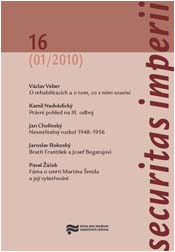Nesmiřitelný rozkol 1948–1956 Politický aktivismus v první etapě českého exilového hnutí
Irreconcilable differences: 1948–1956 Political activism during the first phase of the Czech émigré movement
Author(s): Jan CholínskýSubject(s): Politics, WW II and following years (1940 - 1949), Post-War period (1950 - 1989), History of Communism, Migration Studies
Published by: Ústav pro studium totalitních režimů
Keywords: exile; Czechoslovakia; emigration;February 1948;
Summary/Abstract: This study deals with the formation and activities of political parties and groups of Czech émigrés in the West after the communist putsch in February 1948. The author defends the opinion that, in view of the limited options and “instruments” available in exile, it is more appropriate to use the term “political activism” to describe the given issue rather than “politics”. He points to the fact that political activism became one of the pivotal activities of the wider émigré movement in the period described which comprised at least 60,000 refugees who had escaped the communist regime. The period 1948 to 1956 is demarcated at the outset by the communist seizure of power in Czechoslovakia and its ending is circumscribed by the Soviet military invasion of Hungary and the suppression of the uprising in that country. The author describes these years as the first of a total of four phases that divide the history of the émigré movement into periods of time. Each of these phases is characterised by the consequences of important international watershed events – after the Soviet aggression (and Western passivity) in Hungary in 1956, he cites the Soviet occupation of Czechoslovakia in 1968 and the Helsinki Conference in 1975 as further breaking points. The first of these four periods (which is broadly documented in the study) was typified by a surge in political activism, i.e. by the restoration of political parties and the emergence of distinctive political groupings. Their members and supporters lived in many states, which they had gradually emigrated to from refugee camps, but the main centre of political efforts and actions was the United States. The reason behind the intensive political activism and the fact that this activism was a central theme “of the age” was the belief of an absolute majority of refugees that they would return to their homeland in the foreseeable future when communist supremacy would be replaced by a more liberal political system. Anticipated pressure from the liberal and democratic West, or a possible conflict waged by the West (and led by the United States) against the totalitarian Soviet Union, and the subsequent liberalisation of the Bolshevised satellite states in Central and South-Eastern Europe, were meant to contribute to this. Nevertheless, there was a marked decline in political activism after eight years of exile, which culminated in the Soviet invasion of Hungary and the concurrent passivity of the United States and the entire Western community. This decline was caused by disillusionment at the failure to fulfil the expectations mentioned and the need for people to primarily look after their own welfare during what now looked like a long period of exile. The author describes the first émigré era as a period of irreconcilable differences between two political camps (trends) with competing programmes, which were made up of individual parties and groups. Those who stood against Czech and Slovak representatives and advocates of the post-War National Front (national socialists, social democrats, members of the People’s Party, Slovak democrats and the non-partisan Council of Free Czechoslovakia) comprised Czechs who rejected the Košice Government Programme and the political regime of the so-called “Third Republic” (the Czech National Committee, the Christian Democratic Movement and the Union of Czech Democratic Federalists) and Slovaks who also demanded the restoration of Slovak independence in addition to their rejection of the Košice programme. The basic points at issue were attitudes to the post-War regime (a ban on centrist and right-wing political parties, retributive justice, the nationalisation of assets, and the resettlement of Sudeten Germans versus liberal democratic principles), attitudes to the national rights of Slovaks (an indivisible state union in Czechoslovakia versus the right of Slovaks to self-determination), and attitudes to President Edvard Beneš (a democrat and statesman of outstanding merit versus an irresponsible autocrat and the main culprit behind the tragedy of Czechoslovakia). Another subject that was soon added to this list was the West’s approach to the Cold War (passive acceptance of the Western strategy to weaken Soviet communism with nationalist “Titoist” communism versus active, implacable anti-communism). In this study, the author illustrates the irreconcilable émigré conflict between the exponents of the political trends that have been outlined. (In doing so, he only mentions the Slovak issue in peripheral terms). He also presents in detail individuals and groups belonging to the “anti-Košice” bloc. As he states in his conclusion, he ended up giving preference to this camp partly as a result of the fact that they have been marginalised and excluded by the work of historians up to now, and partly because the erstwhile ideas and political opinions of this faction’s exponents can serve as an inspiration for both contemporary historiography and politics.
Journal: Securitas imperii
- Issue Year: 2010
- Issue No: 16
- Page Range: 52-87
- Page Count: 36
- Language: Czech

